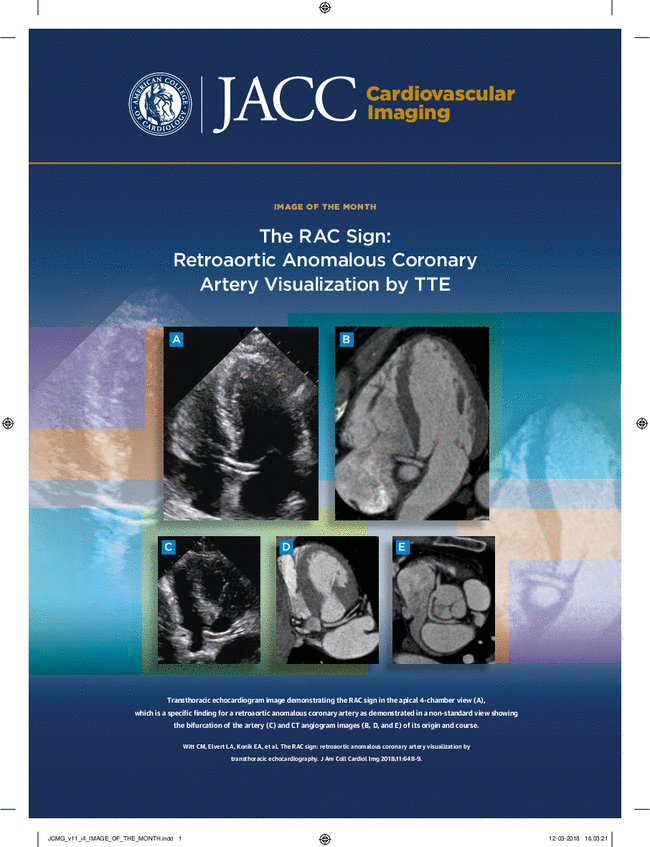Diffuse Interstitial Fibrosis of the Myocardium Predicts Outcome in Moderate and Asymptomatic Severe Aortic Stenosis
IF 12.8
1区 医学
Q1 CARDIAC & CARDIOVASCULAR SYSTEMS
引用次数: 0
Abstract
Background
Patients with moderate or asymptomatic severe aortic stenosis (AS) are at risk of cardiovascular events.
Objectives
The authors investigated the utility of cardiac magnetic resonance (CMR) to identify drivers of outcome in patients with moderate or asymptomatic severe AS.
Methods
A prospective, international, multicenter cohort (n = 457) of patients with moderate (aortic valve area [AVA]: 1.0-1.5 cm2) or asymptomatic severe AS (AVA ≤1.0 cm2 and NYHA functional class I-II) patients underwent CMR. Diffuse interstitial fibrosis and scar in the myocardium were analyzed with extracellular volume fraction (ECV%) and late gadolinium enhancement (LGE). The outcome was a composite of mortality and heart failure admission.
Results
Median ECV% was 26.6% (IQR: 24.4%-29.9%), and LGE was present in 31.5% (median 0.8%; IQR: 0.1%-1.7%). Greater AS severity was associated with greater left ventricular mass and diastolic dysfunction, but not with ECV% or LGE. During a median 5.7 years of follow-up, 83 events occurred. Patients with events had higher ECV% (median ECV% 26.3% vs 28.2%; P = 0.003). Patients in the highest ECV% tertiles (ECV% >28.6%) had worse outcomes both in the entire cohort and in those with NYHA functional class I moderate or severe AS, and ECV% was independently associated with outcome (adjusted HR: 1.05; P = 0.039). The ECV% had significant incremental prognostic value when added to parameters of AS severity and cardiac function, comorbidities, aortic valve replacement, and LGE (P < 0.05).
Conclusions
Increased diffuse interstitial fibrosis of the myocardium is associated with poor outcomes in patients with moderate and asymptomatic severe AS and can help identify those who require closer surveillance for adverse outcomes.
心肌弥漫性间质纤维化可预测中度和无症状重度主动脉瓣狭窄的预后
背景:中度或无症状重度主动脉瓣狭窄(AS)患者有发生心血管事件的风险:作者研究了心脏磁共振(CMR)在确定中度或无症状重度主动脉瓣狭窄患者预后驱动因素方面的作用:对中度(主动脉瓣面积 [AVA]:1.0-1.5 cm2)或无症状重度 AS(AVA ≤1.0 cm2 且 NYHA 功能分级 I-II)患者进行了前瞻性、国际性、多中心队列(n = 457)CMR检查。通过细胞外体积分数(ECV%)和晚期钆增强(LGE)分析心肌弥漫性间质纤维化和瘢痕。结果是死亡率和心力衰竭入院率的综合:中位ECV%为26.6%(IQR:24.4%-29.9%),31.5%出现LGE(中位0.8%;IQR:0.1%-1.7%)。强直性脊柱炎的严重程度与左心室质量和舒张功能障碍的增加有关,但与ECV%或LGE无关。在中位 5.7 年的随访期间,共发生了 83 起事件。发生事件的患者ECV%较高(中位ECV% 26.3% vs 28.2%;P = 0.003)。无论是在整个队列中,还是在 NYHA 功能分级 I 中度或重度强直性脊柱炎患者中,ECV% 最高的三分位数(ECV% >28.6%)患者的预后都较差,ECV% 与预后有独立相关性(调整后 HR:1.05;P = 0.039)。如果将ECV%与AS严重程度和心功能参数、合并症、主动脉瓣置换术和LGE相加,则ECV%具有显著的增量预后价值(P < 0.05):结论:心肌弥漫性间质纤维化的增加与中度和无症状重度强直性脊柱炎患者的不良预后有关,有助于识别需要更密切监测不良预后的患者。
本文章由计算机程序翻译,如有差异,请以英文原文为准。
求助全文
约1分钟内获得全文
求助全文
来源期刊

JACC. Cardiovascular imaging
CARDIAC & CARDIOVASCULAR SYSTEMS-RADIOLOGY, NUCLEAR MEDICINE & MEDICAL IMAGING
CiteScore
24.90
自引率
5.70%
发文量
330
审稿时长
4-8 weeks
期刊介绍:
JACC: Cardiovascular Imaging, part of the prestigious Journal of the American College of Cardiology (JACC) family, offers readers a comprehensive perspective on all aspects of cardiovascular imaging. This specialist journal covers original clinical research on both non-invasive and invasive imaging techniques, including echocardiography, CT, CMR, nuclear, optical imaging, and cine-angiography.
JACC. Cardiovascular imaging highlights advances in basic science and molecular imaging that are expected to significantly impact clinical practice in the next decade. This influence encompasses improvements in diagnostic performance, enhanced understanding of the pathogenetic basis of diseases, and advancements in therapy.
In addition to cutting-edge research,the content of JACC: Cardiovascular Imaging emphasizes practical aspects for the practicing cardiologist, including advocacy and practice management.The journal also features state-of-the-art reviews, ensuring a well-rounded and insightful resource for professionals in the field of cardiovascular imaging.
 求助内容:
求助内容: 应助结果提醒方式:
应助结果提醒方式:


